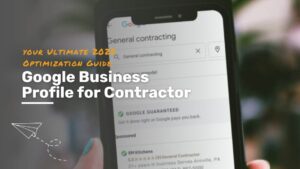The Roofing Lead Generation Landscape in 2025
Roofing contractor leads represent the foundation of any successful roofing business. These are potential customers who’ve shown genuine interest in roofing services by sharing their contact information through various digital and traditional channels. For roofing professionals looking to grow their business in 2025, understanding the evolving lead landscape isn’t just helpful—it’s essential.
The market for roofing leads has transformed dramatically in recent years. Today’s homeowners approach roofing projects differently than they did even five years ago. According to Forrester Research, modern buyers complete between 66% and 90% of their purchasing journey before they ever pick up the phone to call a contractor. This shift means roofing companies need to be visible and credible online long before the customer is ready to talk.
“The most successful contractors we work with understand that generating leads is only half the equation,” says Carl Lefever, Founder & Digital Marketing Strategist at Improve & Grow. “Converting those leads into booked jobs requires both speed and a system for nurturing prospects through their decision process.”
The quality of roofing contractor leads varies dramatically depending on their source. Exclusive, verified leads typically cost more upfront but convert at much higher rates than shared leads. Storm-damage leads often command premium pricing but offer higher ticket values that can justify the investment. The most savvy contractors build a diversified lead strategy that balances immediate needs with long-term growth.
With costs ranging from $75-$150 for basic shared leads to $200-$350 for exclusive, verified opportunities, roofing contractors must carefully evaluate which sources deliver genuine value. The cheapest leads rarely translate to the best return on investment, while the most expensive aren’t automatically worth the premium.
What makes this landscape particularly challenging is the seasonal nature of roofing demand, combined with increasing competition for digital visibility. When storms hit, lead costs spike as demand surges. During slower seasons, even quality leads may require longer nurturing periods before conversion.
The end-to-end journey from lead to completed job has become increasingly complex. Online reviews now play a crucial role in customer decision-making, with 93% of consumers saying reviews impact their purchasing decisions. Meanwhile, the rising costs of digital advertising mean that roofing contractors must be increasingly strategic about where they invest their marketing dollars.
For roofing businesses looking to thrive in this competitive landscape, understanding not just the cost but the quality and conversion potential of different lead sources is essential. The most sustainable approach combines targeted paid strategies for immediate results with long-term investments in owned digital assets that generate leads at decreasing costs over time.
Why Roofing Contractor Leads Matter in 2025
The roofing industry has changed dramatically in recent years. Today’s homeowners aren’t just flipping through the Yellow Pages anymore – they’re researching, comparing, and vetting contractors online before ever picking up the phone.
With 66-90% of the buying process happening before contact, your online presence needs to capture attention early. Trust signals have become non-negotiable – 92% of consumers read online reviews before contacting a company, and 74% say good reviews make a local business more trustworthy.
Meanwhile, digital advertising costs have increased approximately 15-20% year-over-year, making efficient lead generation crucial for your bottom line. Add in increasing storm activity creating demand spikes and growing competitive pressure as the industry consolidates, and you can see why smart lead generation has never been more important.
As Brian Welch, Digital Marketing Strategist at Improve & Grow, explains: “The roofing contractors who thrive today have shifted from a reactive approach—waiting for the phone to ring—to a proactive strategy of building multiple lead channels that they own and control.”
Pay-per-Lead Platforms for Roofing Contractor Leads
Popular home-service platforms such as Angi, HomeAdvisor, Thumbtack, Yelp & Porch connect homeowners with local contractors based on search criteria and reviews. These services typically charge $75-$150 per lead, with those leads being shared among multiple contractors.
The process works like this: homeowners search for roofing services, browse profiles and reviews, request quotes, and contractors pay either a subscription fee or per-lead charge for these connections.
These platforms can serve a purpose in your marketing mix, particularly for newer businesses. They provide built-in trust from the platform’s reputation, create valuable NAP (Name, Address, Phone) citations that boost your local SEO, and offer opportunities to generate reviews.
Jen Leong, Digital Marketing Strategist at Improve & Grow, puts it this way: “Lead platforms work best as supplemental lead sources or for new businesses establishing their online presence. They’re valuable for building reviews and citations, but rarely deliver the best ROI as a primary lead strategy.”
The biggest challenge with these platforms is high competition – often 3-5+ contractors bidding on the same job – which leads to lower conversion rates as homeowners shop around for the best price. You also have limited control over lead quality.
To get the most from these platforms, respond to inquiries within minutes (not hours), complete your profile with high-quality project photos, actively collect and respond to reviews, and carefully monitor your ROI to adjust spending accordingly.
Pricing & ROI Calculator for Roofing Contractor Leads
When it comes to roofing contractor leads, looking beyond the basic cost-per-lead number is essential for understanding your true return on investment. Let’s break down what you can expect to pay and what kind of returns you might see.
The price you’ll pay for quality roofing leads typically ranges from $200-$350, with several key factors influencing where your costs will fall:
Geographic location plays a huge role – leads in competitive urban markets like Philadelphia will cost significantly more than those in rural Pennsylvania. The type of service matters too, with replacement leads commanding higher prices than simple repair leads.
Want exclusive access to your leads? You’ll pay a premium compared to shared leads, but the higher conversion rates often justify the cost. Verification status is another important factor – leads with proper TCPA opt-in verification cost more but protect you legally and tend to convert better. And don’t forget about seasonality – expect prices to climb during peak storm seasons when demand surges.

To calculate your potential ROI on lead generation, this formula provides a clear picture:
ROI = ((Average Job Value × Gross Margin % × Close Rate) - Cost Per Lead) ÷ Cost Per Lead
Let’s see this in action with a realistic example:
- Average residential roof replacement: $12,000
- Gross margin: 35%
- Close rate on exclusive leads: 20%
- Cost per lead: $200
ROI = (($12,000 × 0.35 × 0.20) - $200) ÷ $200
ROI = ($840 - $200) ÷ $200
ROI = $640 ÷ $200
ROI = 5.33 or 533%
That’s a 5X return – for every $200 you invest in leads, you’re generating $640 in gross profit. Not too shabby!
Roofing Contractor Leads Cost Benchmarks
Here’s what you can expect to pay for different types of roofing leads in today’s market:
| Lead Type | Cost Range | Notes |
|---|---|---|
| Pay-per-Lead Platforms | $75-$150 | Unverified, often shared |
| Inbound Leads (SEO/PPC) | $200-$350 | Exclusive, not pre-qualified |
| Appointment-set leads | $300-$500 | Pre-qualified, scheduled |
“The true cost of a lead goes beyond the sticker price,” explains Brian Welch, Digital Marketing Strategist at Improve & Grow. “A $100 shared lead with a 5% close rate actually costs $2,000 per acquisition, while a $200 exclusive lead with a 20% close rate costs $1,000 per acquisition—and delivers a much better customer experience.”
This perspective shift is crucial – sometimes paying more upfront for better leads actually reduces your total customer acquisition cost while improving both conversion rates and customer satisfaction.
Roofing Contractor Leads ROI Break-Even Point
To determine if a particular lead source makes financial sense for your business, calculate your break-even cost per lead:
Break-Even CPL = Average Job Value × Gross Margin % × Close Rate
For instance, if your average job brings in $8,000 with a 30% gross margin and you typically close 15% of your leads, your calculation would be:
$8,000 × 0.30 × 0.15 = $360
This means you could pay up to $360 per lead and still break even. Anything below that threshold generates profit for your business.
Of course, other factors influence your overall ROI picture. Your marketing overhead costs can eat into profits if not managed carefully. Sales team efficiency makes a huge difference – the best leads in the world won’t help if your team doesn’t follow up promptly or effectively. Your follow-up processes should be systemized and consistent for maximum conversion.
Cash-flow timing is another consideration that many roofers overlook, especially with storm work where insurance payments may delay revenue. Finally, don’t forget to factor in the lifetime value from referrals and repeat business – a single good customer might lead to several more through word-of-mouth.
By understanding these cost factors and calculating your specific break-even point, you can make informed decisions about which lead sources deliver the best bang for your buck and build a sustainable pipeline of qualified roofing contractor leads that power your business growth.
How to Vet a Lead Provider & Protect Your Brand
Finding the right roofing contractor leads provider can feel like navigating a minefield. While quality partners can boost your business, the wrong one can drain your budget and potentially damage your reputation.
When evaluating potential lead partners, transparency should be your North Star. Start by asking direct questions about how they generate their leads. Vague answers like “we use digital marketing” aren’t sufficient – reputable providers will explain their specific channels, whether it’s Google Ads, social media, or content marketing.
“The quality of your leads directly reflects the quality of the marketing that generated them,” explains Carl Lefever, Founder & Digital Marketing Strategist at Improve & Grow. “A provider who can’t or won’t explain their lead generation process likely has something to hide.”
Quality assurance processes separate professional lead providers from amateurs. The best companies record calls for quality control and verify lead information before passing it along. Ask how they screen out tire-kickers and ensure you’re getting legitimate prospects.
Don’t overlook the refund policy. Reputable companies stand behind their leads with clear policies for bad leads – whether that’s incorrect phone numbers, leads outside your service area, or prospects with no actual roofing needs. Get this policy in writing before starting.
Data ownership might seem like a technicality, but it matters enormously. You should retain full rights to use the contact information for follow-up and marketing after purchasing the lead. Some providers restrict what you can do with lead data after the initial contact.
Red Flags When Shopping for Roofing Contractor Leads
Watch out for providers requiring long-term contracts without a trial period. Quality lead providers are confident enough in their product to let you test before committing to 6-12 months.
Be extremely wary of recycled leads. Some unscrupulous providers will sell the same lead multiple times over weeks or months, drastically reducing your chances of conversion. Ask directly: “How many times do you sell each lead, and for how long do you keep leads in your system?”
Unverifiable opt-ins should set off immediate alarm bells. If a provider can’t show you their exact opt-in process, they may not be TCPA compliant, potentially exposing you to legal risk.
When pricing seems too good to be true, it usually is. Quality exclusive leads for $20-30 simply don’t exist in today’s market. These “bargains” typically turn out to be shared with dozens of contractors or generated through questionable methods.
Be skeptical of providers without quality guarantees. Professional lead companies stand behind their product with clear policies.
Many low-quality providers use offshore call centers with poor English skills, creating a negative first impression with potential customers. Ask where their call center is located and listen to sample calls if possible.
“The worst-case scenario isn’t just wasting money on poor-quality leads—it’s damaging your brand by being associated with aggressive or non-compliant marketing tactics,” warns Carl Lefever. “Your reputation is worth protecting.”
Must-Have Service Level Guarantees
Before signing with any lead provider, insist on these essential guarantees:
An exclusivity window giving you a defined period (ideally 24-48 hours) where you’re the only contractor contacting the lead. This dramatically improves your chances of conversion and creates a better experience for the homeowner.
A straightforward process for lead credits when you receive invalid information. The best providers make this process simple and don’t argue over every disputed lead.
Real-time delivery ensures you can contact leads while they’re still warm. Leads should arrive immediately via email, text, or directly into your CRM through an integration. Even a 30-minute delay can significantly reduce contact rates.
Insist on geographic accuracy – all leads must be within your specified service area. This seems obvious, but many contractors regularly receive leads from well outside their territory.
Direct support access to a representative who can address issues quickly is crucial. Avoid providers who make you submit tickets to nameless support teams.
Look for transparent reporting that shows detailed analytics on lead sources, quality, and performance. The best providers give you visibility into exactly what you’re paying for.
Finally, request compliance documentation showing evidence of proper consent collection and privacy practices. This protects both you and your customers.
By thoroughly vetting potential lead providers before committing, you’ll not only protect your marketing budget but also ensure your brand is represented professionally to potential customers. Every lead interaction is a reflection of your company, even before you make direct contact.
Inbound vs Purchased Leads: Building a Sustainable Pipeline
The debate between buying leads and building your own lead generation system isn’t just academic for roofing contractors—it’s a strategic decision that affects your bottom line for years to come.
While purchased roofing contractor leads can fill immediate pipeline needs, the long-term math favors developing your own inbound marketing system. Let’s compare the approaches:
| Factor | Purchased Leads | Inbound Leads |
|---|---|---|
| Initial cost | Lower upfront ($0-500) | Higher upfront ($3,000-10,000+) |
| Cost over time | Constant or increasing | Decreasing |
| Brand control | Limited | Complete |
| Lead quality | Variable | Consistently high |
| Exclusivity | Depends on provider | 100% exclusive |
| Asset building | No lasting assets | Builds owned media |
| Scalability | Limited by budget | Compounds over time |
“Inbound marketing is particularly powerful for roofing contractors because of the high-consideration nature of the purchase decision,” explains Scott Rehnberg. “When a homeowner finds your helpful content about hail damage or roof replacement options, you’re positioned as a trusted advisor from the start, not just another contractor calling them.”
The beauty of an inbound approach lies in its compounding returns. Every blog post, every optimized service page, every positive review becomes a permanent asset working for your business 24/7. Unlike purchased leads where you’re essentially “renting” access to someone else’s audience, inbound marketing builds equity in digital assets you actually own.
A robust inbound strategy includes your website, blog content, videos, and email list—all channels you control completely. The SEO value compounds over time, gradually lowering your cost per lead as your content ranks for valuable keywords and builds authority. While the initial investment is higher, many contractors see their lead costs drop below $100 within 12-18 months of consistent inbound marketing.
Beyond cost advantages, inbound leads typically convert at 2-3 times the rate of purchased leads because they found you rather than the other way around. This creates an inherent trust advantage from the very beginning of the relationship.
Learn more about inbound strategies that build sustainable lead pipelines.
Hybrid Model: When to Buy Roofing Contractor Leads
Even with a strong inbound system in place, there are strategic moments when supplementing with purchased leads makes perfect sense:
When entering new markets, purchased leads can help establish a foothold while you build local visibility. During seasonal demand spikes after storms, additional lead sources can help you capitalize on temporary surges in demand. If you need to keep crews busy during slower periods, targeted lead buying can fill gaps in your schedule.
Purchased leads can also be valuable when testing new service offerings before investing heavily in content creation. Some contractors even use them for competitive intelligence—understanding how other lead providers operate in their market.
Carl Lefever recommends: “A balanced approach works best for most roofing contractors. Build your inbound foundation while strategically using purchased leads to fill gaps and maintain steady growth. As your inbound engine gains momentum, you can gradually reduce dependency on purchased leads.”
The key is viewing purchased leads as a supplement to—not a replacement for—your own lead generation system. The contractors who thrive long-term are those who invest in both immediate results and long-term assets.
Scaling Your Inbound Engine Beyond Roofing Contractor Leads
Once your basic inbound system starts delivering consistent results, several advanced strategies can accelerate your growth:
Content clusters create comprehensive information hubs around specific topics like storm damage, roof replacement, or commercial roofing. These topical clusters signal expertise to Google and capture prospects at various stages of the buying journey.
Service-area pages developed for each town or neighborhood you serve improve local visibility and conversion rates. These pages can address specific local challenges, mention landmarks, and include testimonials from nearby customers.
Video case studies showcase your work in a format that builds trust quickly. Before-and-after footage of completed projects, coupled with authentic customer testimonials, creates powerful social proof that text alone can’t match.
Email nurture sequences automatically follow up with leads based on their specific interests. For example, someone who downloaded a guide about roof repairs might receive different follow-up content than someone who requested a replacement estimate.
Brian Welch notes: “The real power of inbound marketing is that it builds on itself. Each piece of content, each backlink, each positive review adds to your digital footprint and makes every future marketing effort more effective.”
This compounding effect is why many roofing contractors who initially balked at the higher upfront cost of inbound marketing become its biggest advocates after experiencing the long-term benefits. While purchased leads will always have their place in a comprehensive strategy, the sustainable competitive advantage comes from building a lead generation system you actually own.
Frequently Asked Questions about Roofing Contractor Leads
How fast should I contact a new roofing contractor lead?
In roofing leads, timing isn’t just important—it’s everything. Industry data reveals a startling truth: contractors who reach out within the first 5 minutes are a whopping 21 times more likely to qualify that lead compared to those who wait just 30 minutes. And if you let a full hour slip by? Your chances of successfully connecting drop by 10 times.
“The moment a homeowner submits their information is when they’re most engaged and ready to talk,” explains Carl Lefever, Founder & Digital Marketing Strategist at Improve & Grow. “Set up immediate notifications for new leads, and have a dedicated person or team responsible for initial contact. Using text messages for initial outreach often works better than calls, as people are more likely to respond to a text than answer a call from an unknown number.”
For your best shot at converting those valuable roofing contractor leads, aim to:
- Respond within 5 minutes during business hours
- Use a mobile-friendly CRM with instant notifications
- Develop a specific protocol for after-hours inquiries
- Implement a 24-48 hour follow-up sequence with multiple contact attempts
The first contractor to make contact often has a significant advantage in winning the job—even if their price isn’t the lowest. Speed signals professionalism and eagerness to serve.
What’s a good close rate on exclusive roofing contractor leads?
Close rates vary significantly depending on your lead source and the type of roofing project. For exclusive leads, here’s what successful contractors typically achieve:
Residential repair leads tend to close at 25-35%, as these are often urgent needs with motivated homeowners. Residential replacement leads typically convert at 15-25%, reflecting the higher price point and more considered purchase decision. Commercial roofing leads generally range from 10-20%, accounting for longer sales cycles and multiple decision-makers. Storm damage leads often perform best at 30-40%, driven by insurance coverage and immediate necessity.
“Your close rate depends heavily on your sales process and follow-up system,” explains Jen Leong, Digital Marketing Strategist at Improve & Grow. “The best contractors don’t just measure overall close rates—they track conversion at each stage of the sales process to identify specific improvement opportunities.”
Several factors can significantly impact your ability to turn roofing contractor leads into paying customers, including how quickly you respond, how thoroughly you qualify prospects upfront, the quality of your inspection process, how professionally you present estimates, what financing options you offer, how persistently you follow up, and the level of competitor activity in your market.
By tracking these metrics separately, you can pinpoint exactly where potential jobs are falling through the cracks and make targeted improvements to your sales process.
Are Local Service Ads better than shared leads for roofers?
For most roofing contractors, Google’s Local Service Ads (LSAs) consistently outperform shared lead services from directories. There are several compelling reasons for this performance gap.
First, LSA leads come from people actively searching for roofing services, not just browsing a directory. The Google Guaranteed badge that appears with your listing instantly builds credibility with potential customers. You’ll only pay when someone contacts you directly—no fees for impressions or clicks that don’t convert. Perhaps most importantly, LSAs appear at the very top of search results, above all other listings including traditional paid ads.
“We’ve seen roofing contractors achieve 20-30% close rates on LSA leads compared to 5-10% on shared leads from directories,” shares Alex Mallin, PPC Specialist at Improve & Grow. “The initial cost per lead might be slightly higher, but the cost per acquisition is significantly lower when you factor in the higher quality and intent of these prospects.”
To get maximum value from your Local Service Ads:
Maintain a stellar review rating of 4.5 stars or higher, as this directly impacts your placement. Respond to new leads within minutes using the Google My Business app. Track lead quality carefully and dispute any invalid leads through Google’s system. Complete every aspect of your business profile for better visibility. Budget consistently to maintain your presence at the top of results.
While shared leads from directories can supplement your pipeline, especially when entering new markets, the exclusive nature and high intent of LSA leads typically deliver superior return on investment for most roofing contractor leads strategies.
Conclusion
Generating high-quality roofing contractor leads is more art than science in today’s digital-first world. Throughout this guide, we’ve explored how the landscape has evolved and what it takes to build a sustainable lead pipeline for your roofing business.
The journey of a homeowner looking for roofing services has fundamentally changed. Most prospects have already researched their options extensively before they ever reach out to a contractor. This shift means your digital presence needs to engage potential customers early and build trust consistently.
“The most successful contractors we work with take a portfolio approach to lead generation,” says Carl Lefever, Founder & Digital Marketing Strategist at Improve & Grow. “They build owned assets through SEO and content marketing while strategically supplementing with high-quality purchased leads during growth phases and peak seasons.”
What’s become clear is that not all leads are created equal. The source, exclusivity, and verification process dramatically impact both quality and conversion rates. Smart contractors understand this distinction and invest accordingly, focusing on channels that deliver the best return on investment.
For most established roofing businesses, a balanced approach works best—combining the immediate results of purchased leads with the long-term value of inbound marketing. This hybrid strategy provides stability while gradually building digital assets you own and control.
Perhaps most importantly, we’ve seen that even the highest quality leads won’t convert without swift follow-up and effective sales processes. The contractors who respond within minutes rather than hours see dramatically better results.
Ready to improve your roofing lead generation strategy? Here’s your action plan:
First, audit your current lead sources to understand the true cost per acquisition, not just the upfront cost per lead. Many contractors are surprised to find their “cheap” leads actually cost more when conversion rates are factored in.
Next, implement robust tracking systems across all channels. You can’t improve what you don’t measure, and understanding which lead sources deliver the best ROI is essential for smart growth.
Then, build your digital foundation with a conversion-optimized website and fully developed Google Business Profile. These owned assets form the cornerstone of effective inbound marketing.
Be sure to develop a systematic follow-up process that ensures every lead receives prompt, consistent contact. The difference between contacting a lead in 5 minutes versus 30 minutes can be the difference between winning and losing the job.
Finally, gradually shift your marketing investment from purely purchased leads toward owned inbound assets. This transition won’t happen overnight, but each step builds equity in your marketing infrastructure.
At Improve & Grow, we specialize in helping roofing contractors build sustainable lead generation systems that deliver predictable growth and decreasing acquisition costs over time. Our data-driven approach combines SEO, PPC, and website optimization to generate high-quality, exclusive leads that convert.
Learn more about our contractor marketing services and how we can help you generate more profitable roofing leads.




